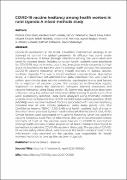| dc.description.abstract | COVID-19 vaccination is the latest preventive intervention strategy in an attempt to control the global pandemic. Its efficacy has come under scrutiny because of break through infections among the vaccinated and need for booster doses. Besides, although health workers were prioritized for COVID-19 vaccine in most countries, anecdotal evidence points to high levels of reluctance to take the vaccine among health workers. We assessed COVID-19 vaccine hesitancy among health workers in Dokolo district, northern Uganda. This was a mixed-method, cross-sectional descriptive study. A customised self-administered data collection tool was used to collect quantitative data on characteristics, vaccination status and factors for or rejection of vaccine uptake. We conducted multivariable logistic regression to assess the association between selected exposures and vaccine hesitancy using Stata version 15. Conversely, qualitative data were collected using key informant interviews (KIIs) among 15 participants that were purposively selected. Data were analysed using thematic content analysis with the help of NVivo 12.0.Of the 346 health workers enrolled, (13.3% [46/346]) were vaccine hesitant. Factors associated with vaccine hesitancy included fear of side effects (Adjusted Odds Ratio [AOR]: 2.55; 95% Confidence Interval [95%CI]: 1.00, 6.49) and health workers’ lack of trust in the information provided by health authorities (AOR: 6.74; 95% CI: 2.43, 18.72). Similar factors were associated with vaccine hesitancy when we used the vaccine hesitancy score. Fear of side effects, distrust in vaccine stakeholders, and lack of trust in the vaccine were barriers to COVID-19 vaccination among health workers. A small proportion of health workers were found to be hesitant to take the COVID-19 vaccine in this study. The paucity of COVID-19 vaccine safety information, which eroded the health workers’ trust in the information they received on the vaccine, was responsible for health workers hesitancy to take up the vaccine in Uganda. | en_US |


